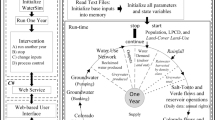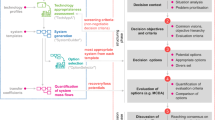Abstract
Urbanization and climate change are straining water resources, necessitating sustainable solutions. Greywater reuse is of paramount importance as it not only conserves freshwater resources but also contributing to sustainable water management efforts. This research aims to design and simulate an efficient water reuse system for a houseboat on the Kaiapoi River in New Zealand using decentralized treatment units. The system integrates river water storage, roof catchment, and greywater and blackwater treatment units, each employing different technologies for treatment. A houseboat's multi-demand water system is designed and simulated to achieve a sustainable approach in water reuse. EPANET's rule-based controls are used for simulation in this research. The research successfully designed and simulated a water reuse infrastructure, reducing freshwater demand by 29% through efficient infrastructure and treated greywater utilization for washing and toilets. The outcomes of this research hold great promise in the context of mitigating water crises, promoting the adoption of groundbreaking technologies, and encouraging sustainable practices. The effective and standards-compliant technologies and daily, weekly, and yearly simulations performed by EPANET. Beyond the immediate application on the houseboat, the effective and standards-compliant technologies and EPANET's comprehensive simulations provide a robust foundation for scaling up the system to serve larger decentralized infrastructures. The research’s outcomes have positive implications for addressing the water crisis in an efficient and sustainable manner. This is achieved by utilizing innovative technologies and sustainable practices. There is a potential to contribute to the development of similar sustainable water systems for households, communities, and industries.
















Similar content being viewed by others
Data availability
Upon request authors are prepared to send relevant documentation or data in order to verify the validity of the results presented in this research.
References
Tsoumachidou S, Velegraki T, Antoniadis A, Poulios I (2017) Greywater as a sustainable water source: A photocatalytic treatment technology under artificial and solar illumination. J Environ Manage 195(Pt 2):232–241. https://doi.org/10.1016/j.jenvman.2016.08.025
Killion SM (2011) Design and Modeling of Infrastructure for Residential and Community Water Reuse University of Nebraska]. Lincoln, Nebraska
Jeong H, Broesicke OA, Drew B, Crittenden JC (2018) Life cycle assessment of small-scale greywater reclamation systems combined with conventional centralized water systems for the City of Atlanta, Georgia. J Clean Prod 174:333–342. https://doi.org/10.1016/j.jclepro.2017.10.193
Zhang Y, Grant A, Sharma A, Chen D, Chen L (2010) Alternative water resources for rural residential development in western Australia. Water Resour Manage 24(1):25–36. https://doi.org/10.1007/s11269-009-9435-0
Digiano FA, Weaver CC, Okun DA (2009) Benefits of shifting fire protection to reclaimed water. J AWWA 101(2):65–74. https://doi.org/10.1002/j.1551-8833.2009.tb09840.x
Chhipi-Shrestha G, Mohammadiun S, Ishaq S, Hu G, Mian H, Pokhrel S, Hewage K, Sadiq R (2021) 10 - Modeling hydraulics and water quality in distribution networks: a review of existing mathematical techniques and software. In: Samui P, Bonakdari H, Deo R (eds) Water Engineering Modeling and Mathematic Tools. Elsevier, pp 187–212. https://doi.org/10.1016/B978-0-12-820644-7.00022-0
Suvizi A, Farghadan A, SahebZamani M (2023) A parallel computing architecture based on cellular automata for hydraulic analysis of water distribution networks. J Parallel Distrib Comput 178:11–28. https://doi.org/10.1016/j.jpdc.2023.03.009
Khor CS, Akinbola G, Shah N (2020) A model-based optimization study on greywater reuse as an alternative urban water resource. Sustain Product Consum 22:186–194. https://doi.org/10.1016/j.spc.2020.03.008
Antonowicz A, Brodziak R, Bylka J, Mazurkiewicz J, Wojtecki S, Zakrzewski P (2018) Use of EPANET solver to manage water distribution in Smart City. E3S Web Conf 30:01016. https://doi.org/10.1051/e3sconf/20183001016
Iglesias-Rey P, Martinez-Solano F, Ribelles-Aquilar JV (2017) Extending EPANET capabilities with add-in tools. Procedia Eng 186:626–634. https://doi.org/10.1016/j.proeng.2017.03.279
Seyoum A, Tanyimboh T (2014) Pressure-dependent network water quality modelling. Water Manag 167:342–355. https://doi.org/10.1680/wama.12.00118
Eid A (2019) Application for Modeling Drinking Water Distribution Systems (EPANET program) Application for Modeling Design 2D Channel Systems (HEC-RAC program).
Stone SL, Dzuray EJ, Meisegeier D, Dahlborg A, Erickson M, Tafuri AN (2002) Decision-support tools for predicting the performance of water distribution and wastewater collection systems. US Environmental Protection Agency, Office of Research and Development
Marunga A, Hoko Z, Kaseke E (2006) Pressure management as a leakage reduction and water demand management tool: The case of the City of Mutare, Zimbabwe. Phys Chem Earth, Parts A/B/C 31:763–770. https://doi.org/10.1016/j.pce.2006.08.032
Ohar Z, Ostfeld A, Lahav O, Birnhack L (2015) Modelling heavy metal contamination events in water distribution systems. Procedia Eng 119:328–336. https://doi.org/10.1016/j.proeng.2015.08.892
Ingeduld P, Pradhan A, Svitak Z, Terrai A (2008) Modelling intermittent water supply systems with EPANET. In: Water Distribution Systems Analysis Symposium 2006 (pp. 1-8). https://doi.org/10.1061/40941(247)37
Health MO (2018) Drinking-water Standards for New Zealand. In: (pp. 128). Wellington, New Zealand: Ministry of Health 128
Funding
The authors declare that no funds, grants, or other support were received during the preparation of this manuscript.
Author information
Authors and Affiliations
Contributions
All authors contributed to the study conception and design. Material preparation, data collection and analysis were performed by Mohammad Ramezanianpour and Akbar Ali. The first draft of the manuscript was written by Mohammad Ramezanianpour and all authors commented on previous versions of the manuscript. All authors read and approved the final manuscript.
Corresponding author
Ethics declarations
Conflict of interests
Over the past three years, the authors have conducted research on water reuse systems with the aim of developing practical solutions for decentralized areas. In this study, the authors focused on the development of a decentralized water reuse system for a houseboat, which they viewed as an innovative case study. Drawing on their professional skills using EPANET software for designing reticulation systems, the authors sought to challenge themselves by exploring the application of this software in a new area of reuse. However, due to limitations in the EPANET software's simple design, the authors were required to perform coding and apply different rule-based scenarios to effectively simulate daily, weekly, monthly, and yearly operation of the system. Additionally, the authors sought to extend their research by simulating the quality of the reused water.
Ethical approval
The authors declare that this research does not involve any Human participation and/or animals. The research was conducted objectively and the authors have no financial or personal relationships with any individuals or organizations that could inappropriately influence or bias the findings of this study.
Consent to participate
As this research involves the analysis of publicly available data and does not involve direct contact with human subjects or their personal information, no consent was required for this study.
Consent to publish
The authors declare that there is no conflict of interest regarding the publication of this research paper.
Rights and permissions
Springer Nature or its licensor (e.g. a society or other partner) holds exclusive rights to this article under a publishing agreement with the author(s) or other rightsholder(s); author self-archiving of the accepted manuscript version of this article is solely governed by the terms of such publishing agreement and applicable law.
About this article
Cite this article
Ramezanianpour, M., Ali, A. Design and simulation of a reuse water system for a houseboat using EPANET. Innov. Infrastruct. Solut. 8, 330 (2023). https://doi.org/10.1007/s41062-023-01294-4
Received:
Accepted:
Published:
DOI: https://doi.org/10.1007/s41062-023-01294-4




